The Hermann’s tortoise is a yellow-brown, thick-scaled tortoise native to Mediterranean Europe. Hermann’s tortoises have two subspecies: the eastern Hermann’s tortoise and the western Hermann’s tortoise.
With laid-back temperaments, Hermann’s tortoises are easy to look after and make good first-time pets for reptile enthusiasts.
Hermann’s Tortoise Overview

Before buying a Hermann tortoise, you should learn the main features of this tortoise to ensure the pet is well-suited to you.
| Common Name(s): | Hermann’s tortoise |
| Scientific Name: | Testudo hermanni |
| Natural Habitat: | Beech and oak forests, rocky hillsides in Mediterranean Europe |
| Adult Size: | 6–8 inches |
| Average Lifespan: | Up to 70 years |
| Diet: | leafy greens, fruits, vegetables |
| Housing: | Minimum 2 by 4 feet, 80–86 °F, 25% humidity |
| Experience level: | Beginner to intermediate |
Origin
Hermann’s tortoise (Testudo hermanni) is found in Mediterranean European countries, including Greece, Romania, Italy, and Bulgaria.
Evergreen forests and rocky, grassy hillsides with scrubby vegetation are the Hermann’s tortoise’s natural environment. This tortoise is used to a dry summer climate and a moist spring.
Hermann’s tortoise population is declining, and the species is classed as “endangered”. There are currently more Hermann’s tortoises in captivity than there are in the wild.
Appearance and Behavior
Hermann’s tortoises have yellow, brown, or orange shells with striking black markings. It’s difficult to tell the eastern Hermann’s tortoise apart from the western Hermann’s tortoise. However, the western subspecies have a slightly higher domed shell.
It can take seven years for the differences between male and female Hermann’s tortoises to become obvious. Male Hermann’s tortoises have longer, thicker tails but are about 12% smaller than females. Males have slightly concave plastrons, while females have flat plastrons.
Size and Lifespan
As medium-sized tortoises, Hermann’s tortoises grow to an average length of 6–8 inches. The western subspecies of Hermann’s tortoise are larger than the eastern subspecies and can reach 11 inches when fully grown.
The average lifespan of Hermann’s tortoise is up to 70 years. Some of Hermann’s tortoises have been known to live longer than this (in fact, the world’s oldest Hermann’s tortoise on record celebrated its 121st birthday in 2019). Make sure you’re prepared for the commitment of owning Hermann’s tortoise — it might just live longer than you.
Temperament
Hermann’s tortoises are gentle, laid-back and passive, and will only bite to defend themselves. You can handle Hermann’s tortoises, but only occasionally, as these tortoises prefer to be grounded.
You shouldn’t house Hermann’s tortoises in the same enclosure. Tortoises can become stressed and may lash out at one another if they’re kept together in the same confined space.
Housing male and female Hermann’s tortoises together are not recommended unless you’re breeding your tortoises. During the mating season, male Hermann’s tortoises can injure the females by chasing and ramming them, which is why you should only bring males and females together for a planned mating.
Housing Hermann’s Tortoises
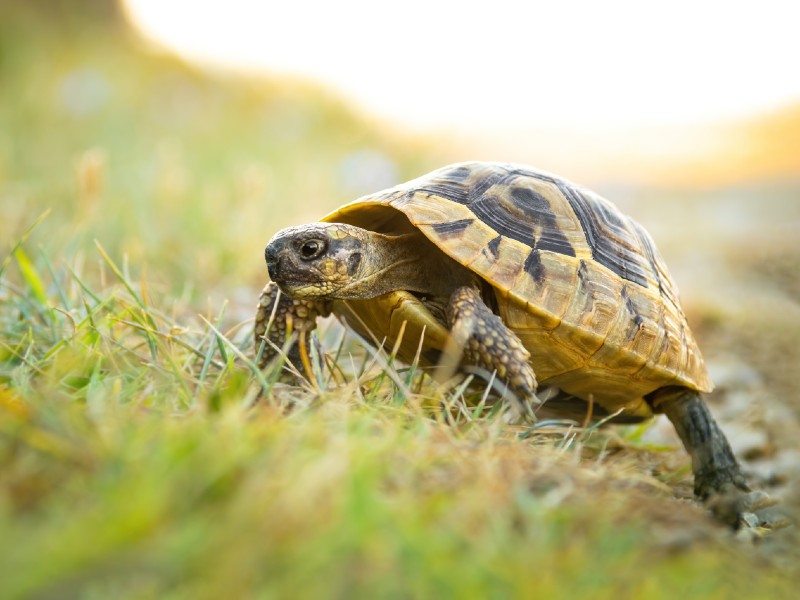
The natural habitat of Hermann’s tortoise is leafy, rocky, and warm. Replicating this environment will help your Hermann’s tortoise to feel most at home in its enclosure.
You should house your Hermann’s tortoise in a wooden vivarium. Wood is the best material for a Hermann tortoise’s enclosure because it insulates heat, which helps to maintain the temperatures inside the vivarium.
If your outdoor climate is similar to the climate of southern European countries, you should house your Hermann’s tortoise outside. While you can house your tortoise indoors, Hermann’s tortoises don’t enjoy being kept inside, which is why you should take this factor into account when deciding whether Hermann’s tortoise is the right pet for you.
Enclosure Size
Hermann’s tortoises like having plenty of space to explore. Your enclosure should measure a minimum of 2 by 4 feet.
If you house your Hermann’s tortoise outside, you will need to install walls or fencing at least 2 feet underground. This will prevent your tortoise from burrowing under the walls and escaping.
Lighting
An outdoor enclosure in a hot, sunny climate doesn’t require additional lighting, as the sun will provide enough light for your Hermann’s tortoise. You shouldn’t house your Hermann’s tortoise outside if you don’t have this climate.
For an indoor enclosure, install a UV strip light and set a timer to mimic a natural day and night cycle.
To synthesize vitamin D3 and absorb calcium for bone growth, Hermann’s tortoises need a steady supply of UVB light. You should equip your indoor enclosure with a 10% fluorescent UVB tube and install a reflector to reflect these rays across the enclosure.
Temperature and Humidity
Your local climate should reach temperatures of 80–86 °F if you plan to house Hermann’s tortoise in an outdoor enclosure. Nighttime temperatures should be around 65–70 °F. Temperatures lower than this can be uncomfortable for Hermann’s tortoises, as they prefer to bask in the warmth.
You can bring your Hermann’s tortoise inside during the winter if it gets too cold. However, make sure to have a suitable enclosure setup prepared in advance if you plan to do this.
If you house your tortoise in an indoor enclosure, you should install a heat lamp or basking lamp that mimics the sun’s rays. Choose a basking spot, such as a large, flat rock that the tortoise can easily access, and place the heat lamp in this location.
Whether your Hermann’s tortoise is housed indoors or outdoors, you should provide a shaded area where your tortoise can cool down away from direct heat or sunlight.
Hermann’s tortoises don’t have stringent humidity requirements, unlike other reptiles. Your enclosure or outdoor environment should have a humidity of at least 25%. This will provide enough moisture for your tortoise.
Substrate and Decoration
The Hermann’s tortoise enjoys digging and burrowing, and the type of substrate you use should be suitable for this activity. A combination of completed cypress bark, sand, and soil is best for Hermann’s tortoise enclosure.
You should line the bottom of your enclosure with at least two feet of the substrate, giving your Hermann’s tortoise plenty of opportunity for digging and exercise.
Decorate your enclosure with artificial plants, such as trailing plants or desert plants. You can also install a cave for your tortoise to hide or sleep in.
Hermann’s tortoises will appreciate a shallow water tub for cooling off and drinking. Sink the tub into the ground to allow for easy access. For outdoor enclosures, plant small bushes and trees to give your tortoise shelter from the sun and hide the tortoise from the view of predators.
You should avoid installing decorations or substrate materials that will increase the humidity of the enclosure. Dry substrate like beechwood chips is best.
Cleaning
To keep your Hermann’s tortoise’s tank clean, you should remove any waste and leftover food, and replace the contents of the water bowl daily.
Every 2–3 weeks, wipe down the enclosure with a reptile cage cleaner or a tortoise-safe disinfectant. Avoid using detergent or soap, as these can harm your pet. Wash your hands after cleaning and before handling your tortoise.
You should move your Hermann’s tortoise to a separate container while cleaning the enclosure. It’s best to dedicate a container solely for this purpose and never use a food container to house your tortoise.
Hermann’s Tortoise Care
Hermann’s tortoises are easy to care for. Their diets aren’t specialized, and they can look after themselves without much intervention.
Food and Water
You should feed your Hermann’s tortoise the sorts of foods it will come across when foraging in the wild. Grasses and leafy greens should make up a big part of your tortoise’s diet. You can also feed your Hermann’s tortoise fruits and vegetables like cucumber, grapes, carrots, melons, cabbage, strawberries, and broccoli.
In the wild, Hermann’s tortoises can also eat small insects and slugs. However, insects should only make up a small portion of your tortoise’s diet. Hermann’s tortoises are primarily vegetarian and prefer a low-protein, high-fiber diet.
Hermann’s tortoises need to be fed once a day. Stick to a feeding schedule and try to feed your tortoise at the same time every day. Give your Hermann’s tortoise enough food for it to eat within 20 and 30 minutes. Your pet should get through a pile of food the size of its shell every day.
Discard any uneaten food after 30 minutes to keep the tank clean and hygienic. You may also grow organic grasses and weeds in your enclosure for your tortoise to graze on throughout the day.
If housing your Hermann’s tortoise indoors, you will need to feed it tortoise food that supplies vitamin D and calcium.
Regular water is fine for your Hermann’s tortoise, although filtered water is better. Make sure to clean out the water tub every day and replenish it with clean water.
Baby Hermann’s tortoises will require less food than adults. Feed your tortoise a small handful of natural foods every day. You can also buy calcium-fortified baby tortoise pellets that can provide your pet with a good source of nutrition. However, fresh, natural plant foods should form the majority of your juvenile tortoise’s diet.
Handling
You can handle Hermann’s tortoises, but these pets don’t enjoy the experience and prefer to be grounded.
If you plan to handle your Hermann’s tortoise, here’s what you should do:
- Wash your hands thoroughly with antibacterial soap.
- Place your hand on a flat surface, palm up, and gently nudge the tortoise onto your palm.
- Support your tortoise firmly to prevent it from kicking away with its legs.
You should wait at least 24 hours after introducing your tortoise to your home before handling it. The exact length of time your pet will tolerate being handled will depend on its individual temperament. Usually, up to 15 minutes of handling, four times a week is suitable.
Common Health Issues
There are several common health issues that a Hermann tortoise in captivity may experience during its life. These include:
Metabolic Bone Disease
The metabolic bone disease usually occurs if Hermann’s tortoise doesn’t get enough calcium in its diet, or if it can’t absorb calcium. You can use liquid calcium supplements to prevent or treat this disease.
Respiratory Infection
Improper heating or lighting, or a poor supply of fresh food and water can cause a respiratory infection in your Hermann’s tortoise. Environmental stressors may also cause respiratory problems. This condition is usually treated with antibiotics.
Cloaca Prolapse
If your Hermann’s tortoise is dehydrated, it has a higher risk of a cloaca prolapse. This occurs when the bladder becomes blocked by hardened urate. You should seek veterinary help if your tortoise doesn’t want to eat or has a reduced fecal output.
Mating Injuries
Female Hermann’s tortoises are susceptible to injury during the mating season. If you’re breeding a pair of tortoises, monitor the female for open wounds and isolate her if she’s injured. Clean the wound with an antibacterial ointment. If you’re worried, contact an exotics veterinarian for their advice.
Hibernation
Hermann’s tortoises will hibernate if the temperature in the enclosure falls below 50 °F. Hibernation begins in October and can last until March or April. You can prevent hibernation by keeping your enclosure’s temperature the same year-round or bringing your tortoise inside to a heated enclosure in the winter.
Breeding
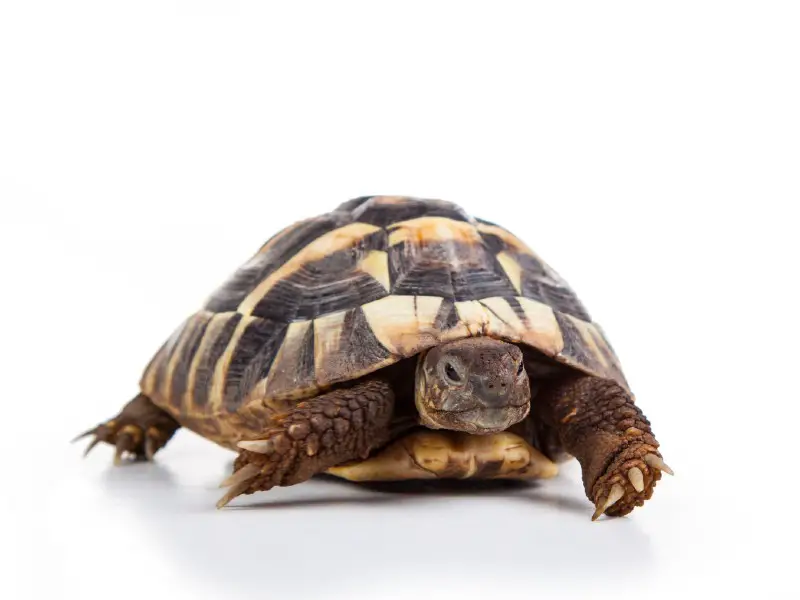
Breeding Hermann’s tortoises can be quite dangerous, because the males bully the females into submission with ramming, butting, and biting. You should only breed Hermann’s tortoises if you’re an experienced reptile keeper.
To breed a Hermann’s tortoise, here’s what you should do:
- Place a healthy male and female tortoise in a warm enclosure with plenty of natural sunlight.
- The male will follow the female’s scent and proceed to ram her shell and bite her head and limbs. If the female is receptive, she will submit to the male’s attention, and the pair will mate. Remove the female if you notice any signs of injury.
- Up to 30 of the female’s eggs can be fertilized, but she may not lay them in one clutch. A female tortoise will usually lay two to 12 eggs at a time.
- The female will look for a suitable nesting area to lay her first clutch. She will then incubate this clutch, before laying the next clutch. You can buy a reptile incubator to place in the enclosure for this occasion. The process of laying and incubating can continue for several months or even years.
- The eggs will hatch after 8–10 weeks. All the eggs from one clutch won’t hatch on the same day.
- Give your baby tortoises a bath to clean their skin and shells, and encourage them to have their first drink.
Choosing and Buying a Hermann’s Tortoise
Hermann’s tortoises cost, on average, $100–$450 per tortoise. Older tortoises are more expensive than juveniles because you won’t have to pay to raise mature tortoises.
You can buy Hermann’s tortoises from pet stores and breeders. Buying from a reputable breeder will ensure you have a healthy tortoise.
When examining a Hermann tortoise you plan to buy, look for a smooth shell, clear eyes, and a clean fecal vent. These features suggest that the tortoise has been raised well and should live a long, happy life in your care.

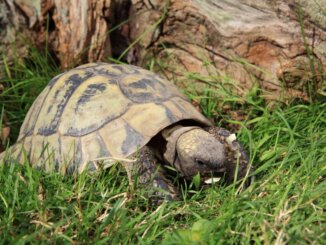
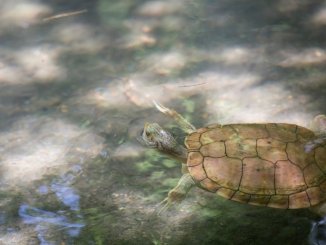
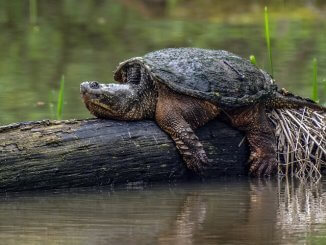

I want to get a Herman’s tortoise.
Glad the article inspired you.